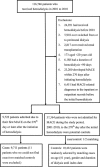Association Between Vascular Access Dysfunction and Subsequent Major Adverse Cardiovascular Events in Patients on Hemodialysis: A Population-Based Nested Case-Control Study
- PMID: 26131808
- PMCID: PMC4504615
- DOI: 10.1097/MD.0000000000001032
Association Between Vascular Access Dysfunction and Subsequent Major Adverse Cardiovascular Events in Patients on Hemodialysis: A Population-Based Nested Case-Control Study
Abstract
The association between dialysis vascular access dysfunction and the risk of developing major adverse cardiovascular events (MACE) in hemodialysis patients is unclear and has not yet been investigated. We analyzed data from the National Health Insurance Research Database of Taiwan to quantify this association. Adopting a case-control design nested within a cohort of patients who received hemodialysis from 2001 to 2010, we identified 9711 incident cases of MACE during the stage of stable maintenance dialysis and 19,422 randomly selected controls matched to cases on age, gender, and duration of dialysis. Events of vascular access dysfunction in the 6-month period before the date of MACE onset (ie, index date) for cases and before index dates for controls were evaluated retrospectively. The presence of vascular access dysfunction was associated with a 1.385-fold higher odds of developing MACE as estimated from the logistic regression analysis. This represents a significantly increased adjusted odds ratio (OR) at 1.268 (95% confidence interval [CI] = 1.186-1.355) after adjustment for comorbidities and calendar years of initiating dialysis. We also noted a significant exposure-response trend (P < 0.001) between the frequency of vascular access dysfunction and MACE, with the greatest risk (adjusted OR = 1.840, 95% CI = 1.549-2.186) noted in patients with ≥3 vascular access events. We concluded that dialysis vascular access dysfunction was significantly associated with an increased risk of MACE. Hence, vascular access failure can be an early sign for MACE in patients receiving maintenance hemodialysis. Active monitoring and treatment of cardiovascular risk factors and related diseases, not merely managing vascular access dysfunction, would be required to reduce the risk of MACE.
Conflict of interest statement
The authors have no conflicts of interest to disclose.
Figures
Similar articles
-
Association of Dysfunction of Vascular Access for Hemodialysis With Major Adverse Cardiovascular Events - A Group-Based Trajectory Model Analysis.Circ J. 2020 May 25;84(6):1004-1011. doi: 10.1253/circj.CJ-19-1036. Epub 2020 Apr 22. Circ J. 2020. PMID: 32321881
-
Association of serum resolvin D1 with the risk of major adverse cardiovascular events in hemodialysis patients.Int Urol Nephrol. 2025 Jan;57(1):197-203. doi: 10.1007/s11255-024-04152-z. Epub 2024 Jul 19. Int Urol Nephrol. 2025. PMID: 39028494
-
Grading of Left Ventricular Diastolic Dysfunction with Preserved Systolic Function by the 2016 American Society of Echocardiography/European Association of Cardiovascular Imaging Recommendations Contributes to Predicting Cardiovascular Events in Hemodialysis Patients.Cardiorenal Med. 2019;9(3):190-200. doi: 10.1159/000496064. Epub 2019 Mar 7. Cardiorenal Med. 2019. PMID: 30844787
-
Angiotensin Receptor Blockers Decrease the Risk of Major Adverse Cardiovascular Events in Patients with End-Stage Renal Disease on Maintenance Dialysis: A Nationwide Matched-Cohort Study.PLoS One. 2015 Oct 21;10(10):e0140633. doi: 10.1371/journal.pone.0140633. eCollection 2015. PLoS One. 2015. PMID: 26488749 Free PMC article.
-
[The Veneto Region's Registry of Dialysis and Transplantation: 2006-2007 report].G Ital Nefrol. 2009 Nov-Dec;26 Suppl 48:S5-56. G Ital Nefrol. 2009. PMID: 19927265 Italian.
Cited by
-
Antiplatelet agents maintain arteriovenous fistula and graft function in patients receiving hemodialysis: A nationwide case-control study.PLoS One. 2018 Oct 18;13(10):e0206011. doi: 10.1371/journal.pone.0206011. eCollection 2018. PLoS One. 2018. PMID: 30335833 Free PMC article.
-
Factors affecting fistula failure in patients on chronic hemodialysis: a population-based case-control study.BMC Nephrol. 2018 Aug 22;19(1):213. doi: 10.1186/s12882-018-1010-6. BMC Nephrol. 2018. PMID: 30134859 Free PMC article.
-
Incidence and Predictors of Acute Coronary Syndrome in Patients on Maintenance Hemodialysis: A Prospective Cohort Study.Acta Cardiol Sin. 2024 Mar;40(2):191-199. doi: 10.6515/ACS.202403_40(2).20231022A. Acta Cardiol Sin. 2024. PMID: 38532820 Free PMC article.
-
Association of early loss of primary functional patency of arteriovenous access with mortality in incident hemodialysis patients: A nationwide population-based observational study.Medicine (Baltimore). 2018 Aug;97(31):e11630. doi: 10.1097/MD.0000000000011630. Medicine (Baltimore). 2018. PMID: 30075542 Free PMC article.
-
Long-Term Arteriovenous Access Clinical Patency Following Successful Thrombolysis: A Single-Centre Experience.Cureus. 2025 Apr 6;17(4):e81779. doi: 10.7759/cureus.81779. eCollection 2025 Apr. Cureus. 2025. PMID: 40330374 Free PMC article.
References
-
- Santulli G. Epidemiology of cardiovascular disease in the 21st century: updated numbers and updated facts. J Cardiovasc Dis 2013; 1:1–2.
-
- Foley RN, Parfrey PS. Cardiovascular disease and mortality in ESRD. J Nephrol 1998; 11:239–245. - PubMed
-
- Collins AJ, Foley RN, Herzog C, et al. US Renal Data System 2012 Annual Data Report. Am J Kidney Dis 2013; 61 (Suppl 1):A7.e1-476. - PubMed
-
- Goodkin DA, Bragg-Gresham JL, Koenig KG, et al. Association of comorbid conditions and mortality in hemodialysis patients in Europe, Japan, and the United States: the Dialysis Outcomes and Practice Patterns Study (DOPPS). J Am Soc Nephrol 2003; 14:3270–3277. - PubMed
-
- Sarnak MJ, Levey AS, Schoolwerth AC, et al. Kidney disease as a risk factor for development of cardiovascular disease: a statement from the American Heart Association Councils on Kidney in Cardiovascular Disease, High Blood Pressure Research, Clinical Cardiology, and Epidemiology and Prevention. Circulation 2003; 108:2154–2169. - PubMed
Publication types
MeSH terms
LinkOut - more resources
Full Text Sources
Medical


